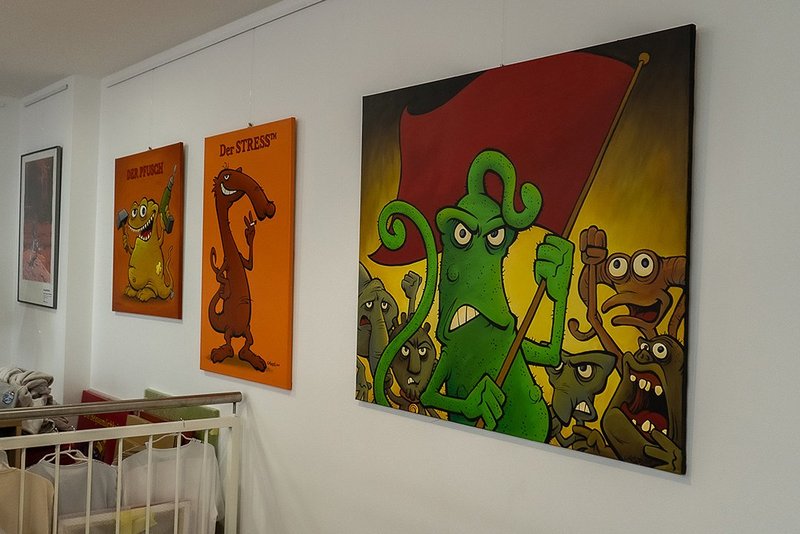
ToyCity tour of discovery
Nuremberg: where the past and future meet
By Anja Kummerow
In Nuremberg, the future and the past exist side by side. To move nimbly between both worlds you need only visit the city centre, with its many interesting museums and cultural monuments. There you can experience a great deal of the city’s history and vibrant development while also getting a feel for Nuremberg’s importance as a toy city.
Besides its splendid capacity to satisfy your hunger for knowledge, Nuremberg also has many bars, mostly centrally located, where you can quench your thirst – whether with a local beer, a glass of wine or a good cocktail. Indeed, seven bars in Nuremberg and Fürth are serving the special concoction for the Nuremberg Spielwarenmesse: the ToyCocktail. This year, Herrengedeck bar won the competition with its creation “Pearplex”.
Kaiserburg: get your bearings with a grandiose view

If you wish to start with a good overview of the city, Kaiserburg (Imperial Castle) is the place to begin. It ranks among Neuschwanstein Castle, Munich’s Marienplatz central square and Regensburg’s Walhalla memorial as one of Bavaria’s foremost attractions. The earliest buildings in the large complex were erected in the first half of the 11th century. The castle served as an important base: many rulers held court assemblies and imperial diets here as they journeyed through the realm. You can see far beyond the city centre at the top of this 351m high fortification.
Albrecht Dürer’s House: at home with Germany’s best-known artist
Descend from the castle, keeping to your right, and you’ll come to what was the home of Germany’s most famous artist, Albrecht Dürer (1471–1528), whose best-known artworks include Young Hare and Praying Hands. He lived at this house with his wife Agnes from 1509. It is one of the few surviving burgher houses from Nuremberg’s golden age and the only 16th century artist’s house still standing in northern Europe.
Doll’s hospital: first aid for much-loved toys
From here you are almost immediately on Nuremberg’s toy trail. Missing arms can be replaced and broken eyes repaired in the doll’s hospital at Untere Krämersgasse 16. Help is at hand here for teddy bears and soft toys that have seen better days as well. Owner Rose Weihreter also offers puppets, magicians and witches for sale in this space measuring 12 square metres.
Latest at the Toy Museum: a cultural history of Turkey

Back in the Middle Ages, toys were already being made in the streets of the old town and practically all across the city of Nuremberg. Hundreds of establishments produced wooden toys, tin figures, Nuremberg kitchens, play shops and, in particular, metal playthings. This is also evident at the Toy Museum. Sunay Akιn, a well-known poet, cultural scientist and journalist from Istanbul, was so impressed by what he saw at the museum that he began himself in 1989 to collect traditional Turkish toys. His collection, which also offers insights into Turkish cultural history, can be seen at the Toy Museum until the end of April 2024.
Hauptmarkt: turn the ring, please

Nuremberg’s main market square, the Hauptmarkt, is no distance from the Toy Museum. The eye-catcher here is definitely the Schöner Brunnen fountain, which originally dates from the 14th century. Legend has it that turning the ring seamlessly embedded in the metal fence will make your wishes come true. The original went missing during restoration work, so it doesn’t matter whether you opt to turn the dark iron or golden brass ring – both are copies from the 20th century.
Frauenkirche: the place to see the Christkind
The main market square is further home to the Frauenkirche (Church of Our Lady), which was also built in the 14th century. It contains numerous artworks from the Middle Ages, but there is plenty to see outside as well – such as the ornate mechanical clock. Every day at noon, seven figures representing prince-electors pay homage, moving three times around an emperor figure. The Männleinlaufen clock was donated by Charles IV, Holy Roman Emperor, in 1356. The Christ Child, or Christkind, makes a speech from the church balcony each year on the Friday preceding the first Sunday in Advent to open Nuremberg’s famous Christmas market, the Christkindlesmarkt.
Future Museum: how we’ll live and work tomorrow

After all of that history, it’s high time we turn our gaze towards what lies ahead. On the other side of the main market square, we can move directly along the Augustinerhof to the Future Museum. Even on the way there, you already get a futuristic feel. The museum has five exhibition areas on three levels: Work and Daily Life, Body and Mind, City System, Earth System, and Space and Time. There are also special exhibitions on robots, living machines and prototypes. The exhibits are designed to help us find answers to questions such as: what can artificial intelligence do? Will humans and machines become one?
Josephs: try out tomorrow’s innovations today
It stands to reason that an institute devoted to innovation should have its focus on tomorrow. That’s why Josephs – innovation lab and experience – has moved into the Future Museum building. Abstract ideas and concepts can be transformed into prototypes here and tested with the help of target groups to identify potential improvements and advancements. The idea behind Josephs has already been exported from Nuremberg to many major cities.
DB Museum: big trains instead of models

Anyone who makes a beeline for the model railway category at the Spielwarenmesse also has the opportunity in Nuremberg to marvel up close at many of the originals. Indeed, the history of the railway in Germany began in 1835 with a six-kilometre journey from here to Fürth: with the famous Adler locomotive. Across two floors, the DB Museum takes visitors on a journey through more than 200 years of that history in Germany and the railway’s relationship with technology, the economy, society and culture.
Bar scene: plenty of good watering holes
The dining car is no longer serving? No problem! Nuremberg has a bustling and great bar scene. If you would like to end your walkabout with another impressive view, then stay near the trains and try to grab a spot in the relatively new sky bar at Motel One, right next to the train station. A hearty beer can be enjoyed at Nuremberg Balcony directly at the entrance to the Handwerkerhof artisans’ yard and exquisite drinks at the Hotel Sieben Raben or – back at the main market square – Heinrich’s bar.
ToyCocktail: here’s to doing good business!

If, however, you want to enjoy the ToyCocktail, a total of seven venues can mix you this year’s winning concoction – the Pearplex: a blend of cognac, lemon juice, maple syrup, Williams Birne (pear brandy) and red port. Get yours at Herrengedeck (the winning bar), Enchilada Nürnberg, Bahama Bar y Restaurante, Die Rote Bar, Tinto – tapas y vino, Treff at the Arvena Park Hotel or Castros Bar & Event in Fürth. While relaxing after your fascinating tour of Nuremberg, you can then also raise a glass to doing good business at the Spielwarenmesse!
Bring your day to a close in the ToyCity of Nuremberg!
Your admission ticket for the Spielwarenmesse gets you directly to the city centre as it is also valid for travel on public transport on the printed event days, covering the metro (U-Bahn) and all other trains in the Transport for Greater Nuremberg (VGN) network in the 100/200 zone (Nuremberg, Fürth, Stein).
Head to the city centre
Check out the ToyCity events around the Spielwarenmesse
About the author:
Anja Kummerow spent more than 20 years reporting on Nuremberg’s exciting companies and many interesting trade fairs, like the Spielwarenmesse, in her role as business editor for the Nürnberger Zeitung newspaper. She has been a freelance journalist, speech writer and book author since 2020.




